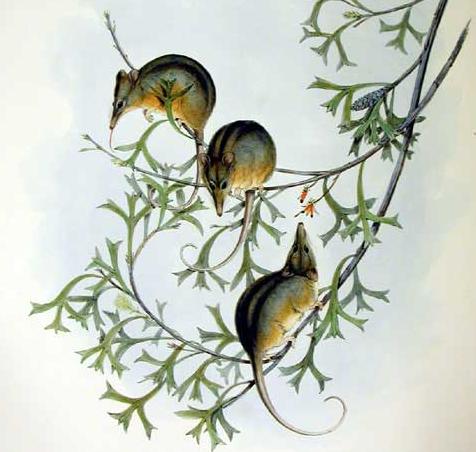- Honey Possum
Taxobox
name = Honey PossumMSW3 Groves|pages=55-56]

status = LC
status_system = iucn3.1
status_ref = IUCN2006|assessors=Australasian Marsupial & Monotreme Specialist Group|year=1996|id=40583|title=Tarsipes rostratus|downloaded=12 May 2006]
regnum =Animal ia
phylum = Chordata
classis =Mammal ia
infraclassis =Marsupialia
ordo =Diprotodontia
familia = Tarsipedidae
familia_authority = Gervais & Verreaux, 1842
genus = "Tarsipes"
genus_authority = Gervais & Verreaux, 1842
species = "T. rostratus"
binomial = "Tarsipes rostratus"
binomial_authority = Gervais & Verreaux, 1842The Honey Possum ("Tarsipes rostratus") or Noolbenger is a tiny
Australia nmarsupial weighing just seven to eleven grams for the male, and eight to sixteen grams for the female—about half the weight of a mouse. Their physical size ranges from a body length of between 6.5 – 9 cm. They have a typical lifespan of between one and two years.cite book| last = Branson| first = Andrew| coauthors = Martyn Bramwell, Robin Kerrod, Christopher O'Toole, Steve Parker, John Stidworthy| title = The Illustrated Encyclopedia of Mammals| publisher =Andromeda Oxford | date =1993| pages = 26-27| isbn = 1-871869-16-1 ]The Honey Possum has no close relatives. It is currently classified as the only member of the genus "Tarsipes" and of the family Tarsipedidae, but many authorities believe that it is sufficiently distinct to be more properly raised to a separate
superfamily within theDiprotodontia , or perhaps even further. It is thought to be the sole survivor of an otherwise long-extinctmarsupial group. Although restricted to a fairly small range in the southwest ofWestern Australia , it is locally common and does not seem to be threatened with extinction so long as its habitat of heath, shrubland and woodland remains intact and diverse.It is one of the very few entirely
nectar ivorous mammals; it has a long, pointed snout and a long, protusible tongue with a brush tip that gatherspollen andnectar , like ahoneyeater or ahummingbird . It's teeth are fewer and smaller than is typical for marsupials, with the molars reduced to tiny cones, and a dental formula of dentition|2.1.1.3|1.0.0.3Floral diversity is particularly important for the Honey Possum as it cannot survive without a year-round supply of nectar, and unlike nectarivorous birds, it cannot easily travel long distances in search of fresh supplies. Both its front and back feet are adept at grasping, enabling them to climb trees with ease, as well as traverse the
undergrowth at speed. Honey Possums can also utilise theirtail (which is longer than their head and body combined) to grip, much like another arm.The Honey Possum is mainly nocturnal but will come out to feed during daylight in cooler weather. Generally, though, it spends the days asleep in a shelter of convenience: a rock cranny, a tree cavity, the hollow inside of a grass tree, or an abandoned bird nest. When food is scarce or in cold weather, it becomes torpid to conserve energy.
Breeding occurs during early
summer , and Honey Possums typically begin to mate once they reach an age of six months, the fathers leaving as soon as the mating is over. Theirgestation period lasts for about twenty eight days, and they typically produce two to fouroffspring . Once born, the babies will take refuge inside the mother's pouch and feed on her milk for around eight weeks until they grow a coating offur which will enable them to survive outside of the pouch. As soon as they emerge, they are often left in a sheltered area (such as a hollow in a tree) while the mother searches forfood for herself, but within days they learn to grab hold of the mother's back and travel with her. However, their weight soon becomes too much, and they will stop feeding offmilk at around eleven weeks, and start to make their own homes shortly after this.Most of the time, Honey Possums will stick to separate territories of about one hectare (2.5 acres)cite book |editor=Macdonald, D.|author= Russell, Eleanor M.|year=1984 |title= The Encyclopedia of Mammals|publisher= Facts on File|location=New York|pages= 878-879|isbn= 0-87196-871-1] , outside of the breeding season. They live in small groups of no more than ten, which results in them engaging in combat with one another only rarely. During the breeding season, females will move into smaller areas with their young, which they will defend fiercely, especially from any males.
References
Wikimedia Foundation. 2010.
